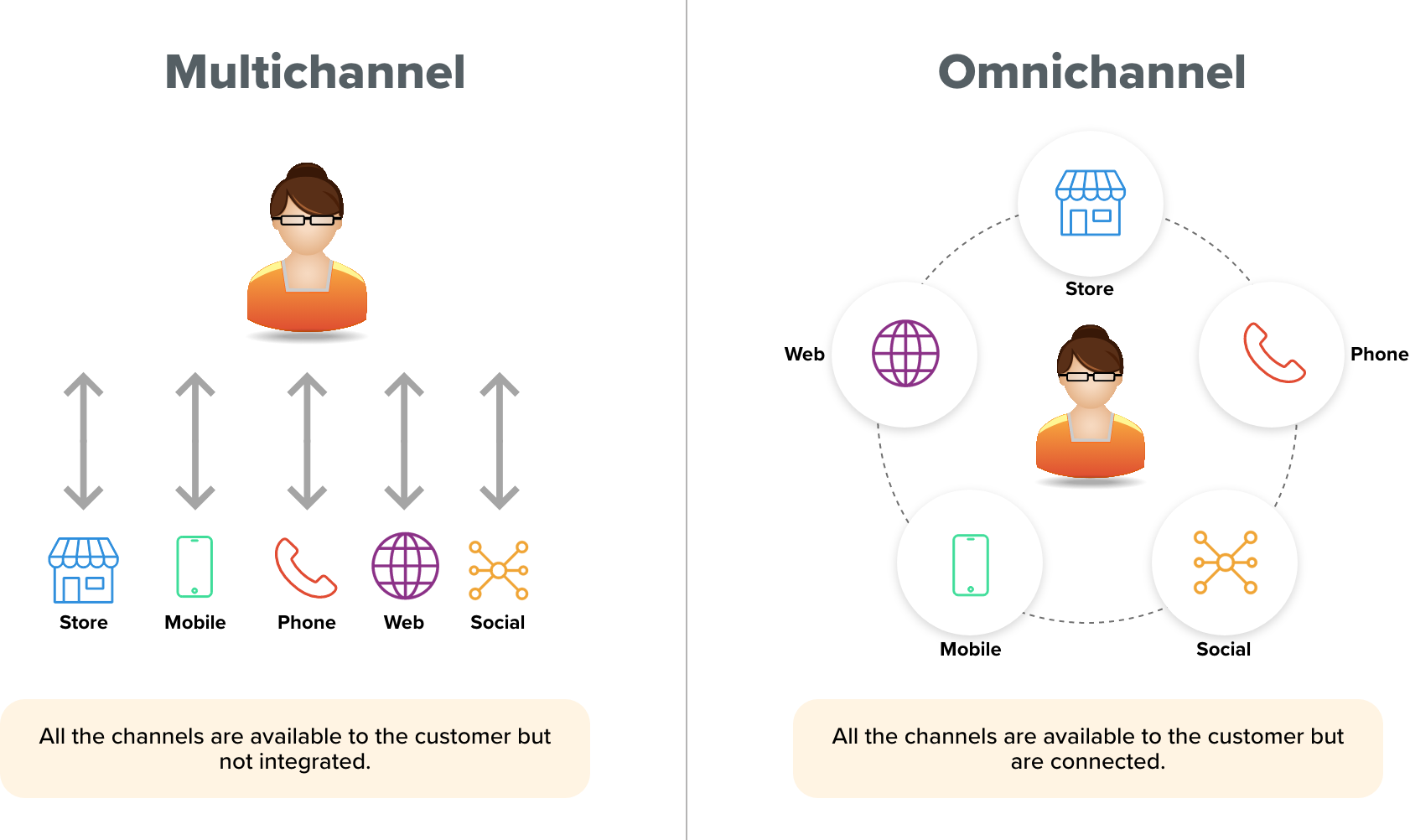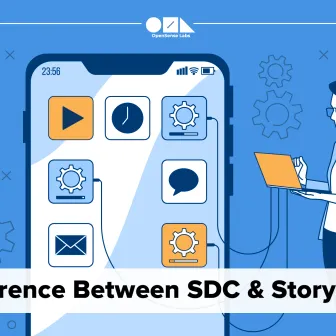With the changing digital times, customers have become more empowered and demanding. They expect personalized, relevant, and consistent experiences across multiple channels. This is where omnichannel marketing comes into play.
Omnichannel marketing is a strategy that aims to provide a seamless and integrated customer experience across various channels and touchpoints, both online and offline. Unlike multichannel marketing, which focuses on using multiple channels independently, omnichannel marketing ensures that each channel works together harmoniously to deliver a unified experience.
Brands with top omnichannel customer engagement see a 9.5% yearly increase in annual revenue, compared to 3.4% for poor omnichannel brand strategies.
The research can be backed up with many examples like, a customer may start browsing products on a company's website, add items to their cart, and then decide to visit a physical store to make the final purchase. With omnichannel marketing, the customer's journey is continuous and consistent. They can access their cart on the mobile app, receive personalized offers via email, and have a smooth transition between the online and offline channels.
By adopting an omnichannel approach, businesses can provide a cohesive brand experience, build stronger relationships with customers, and create a competitive advantage in the market.
In the upcoming sections of this blog, we will explore how Drupal, a robust content management system, enables businesses to enhance customer engagement and experience through its omnichannel capabilities. We will delve into Drupal's features, case studies, best practices, and the overall impact it can have on businesses seeking to deliver exceptional customer experiences in today's digital landscape.
Understanding Customer Engagement and Experience
Customer engagement refers to the level of interaction and involvement customers have with a brand or company. It goes beyond a simple transaction and encompasses the emotional connection, loyalty, and active participation of customers in various activities associated with the brand. Customer engagement can be measured through repeat purchases, social media interactions, customer feedback, and more.
To enhance customer engagement, businesses employ various strategies such as personalized marketing campaigns, loyalty programs, social media engagement, and excellent customer service.
|
Customer Channels |
Percentage of Customers' Preferred Channels |
|---|---|
|
Website |
42% |
|
Mobile App |
28% |
|
Social Media |
18% |
|
|
8% |
|
Physical Store |
4% |
The data here shows the percentages based on a survey of 1000 customers, it explains how the data is diversly distributed among different channels.
The impact of customer experience
Customer experience refers to customers’ overall perception of a brand based on their interactions across various touchpoints. It encompasses every customer interaction with a company, including browsing a website, using a mobile app, contacting customer support, or visiting a physical store.
Delivering a seamless and exceptional customer experience is crucial for businesses as it directly influences customer satisfaction, loyalty, and advocacy. Positive customer experiences lead to increased brand trust, repeat purchases, and positive word-of-mouth recommendations.
On the other hand, a poor customer experience can result in customer churn, negative reviews, and a damaged brand reputation.
By focusing on customer experience, businesses can differentiate themselves from competitors and build long-term relationships with their customers.
What is omnichannel marketing?
Omnichannel marketing is a strategy that aims to provide a seamless and integrated customer experience across multiple channels and touchpoints. It focuses on creating a cohesive and consistent brand experience, regardless of the channel or device the customer uses to interact with the brand.
Unlike multichannel marketing, which treats each channel as a separate entity, omnichannel marketing takes a customer-centric approach, ensuring that all channels work together harmoniously to deliver a unified experience. It recognizes that customers may engage with a brand through various channels such as websites, mobile apps, social media, email, physical stores, and more, and aims to provide a seamless transition between these channels.
Benefits of omnichannel marketing
Omnichannel marketing offers numerous benefits for businesses aiming to provide a seamless and personalized customer experience. By integrating various channels and touchpoints, businesses can enhance customer engagement, drive brand loyalty, and ultimately increase sales and revenue.
These advantages highlight the significance of implementing an omnichannel approach in today's competitive market, where customer expectations and preferences continue to evolve.
- Seamless Customer Experience: Omnichannel marketing ensures a consistent and seamless experience for customers across different channels and touchpoints. Whether they are browsing online, using a mobile app, visiting a physical store, or interacting on social media, customers can expect a cohesive brand experience. This integrated approach eliminates silos and provides a unified brand identity, making it easier for customers to engage with the brand at their convenience.
- Increased Customer Engagement: Omnichannel marketing allows businesses to reach customers at various stages of their buying journey and on the channels they prefer. By delivering personalized and relevant content across multiple touchpoints, businesses can capture customers' attention and encourage active participation. Engaging customers through multiple channels not only increases their brand interaction but also deepens their connection, fostering loyalty and advocacy.
- Data-Driven Insights: Implementing an omnichannel strategy provides businesses with valuable data and insights into customer behavior and preferences. By collecting data from different channels and touchpoints, businesses can gain a comprehensive understanding of customer interactions and preferences. This data-driven approach enables informed decision-making, facilitates targeted marketing campaigns, and helps optimize the overall customer experience.
- Improved Targeting and Personalization: Omnichannel marketing enables businesses to deliver highly targeted and personalized messages to customers. By integrating customer data from various channels, businesses can create a holistic view of each customer and tailor their marketing efforts accordingly. Personalized marketing messages based on customer preferences, behaviors, and purchase history are more likely to resonate with customers, driving higher engagement and conversion rates.
- Optimized Marketing ROI: Adopting an omnichannel approach allows businesses to optimize their marketing return on investment (ROI). By strategically allocating resources across different channels based on customer preferences and data insights, businesses can maximize the impact of their marketing efforts. Additionally, omnichannel marketing facilitates better attribution modeling, enabling businesses to accurately measure the contribution of each channel to overall sales and revenue, leading to more effective resource allocation and budget optimization.
Omnichannel vs Multichannel Experience
Businesses strive to provide exceptional customer experiences to stay competitive. Two approaches that often come up in this context are omnichannel and multichannel experiences. While they may sound similar, there are fundamental differences between the two strategies.

Multichannel Experience:
Multichannel experience refers to a marketing approach where businesses use multiple channels to reach and engage with customers. Each channel operates independently, offering its own set of touchpoints and interactions. For example, a company may have a website, social media presence, physical stores, and a call center, with each channel functioning separately from the others.
The key characteristic of a multichannel experience is that each channel operates in silos, often with different strategies, messaging, and objectives. Customers may have distinct experiences when interacting with the brand across different channels. While multichannel strategies allow businesses to have a presence on various platforms, they often lack integration and consistency.
Omnichannel Experience:
On the other hand, the omnichannel experience focuses on creating a seamless and integrated customer journey across multiple channels. Unlike multichannel strategies, omnichannel aims to deliver a consistent and unified brand experience, regardless of the channel or device used by the customer.
In an omnichannel approach, all channels work together in harmony, sharing data and insights to provide a cohesive and personalized experience. For instance, a customer can start a transaction on a website, continue it on a mobile app, and finalize it at a physical store, with the transition being smooth and uninterrupted.
Omnichannel strategies leverage technology and data integration to ensure that customer interactions, preferences, and purchase history are synchronized across channels. This allows businesses to deliver personalized content, targeted offers, and a seamless experience that caters to the individual customer's needs and preferences.
|
Omnichannel Experience |
Multichannel Experience |
|
Seamless and integrated customer experience across channels |
Disconnected customer experiences across channels |
|
Consistent brand experience across touchpoints |
Inconsistent brand experience across touchpoints |
|
Smooth transition between online and offline channels |
The disjointed transition between online and offline channels |
|
Channels work together harmoniously to deliver a unified experience |
Channels operate independently, lacking integration |
|
Personalized and relevant content tailored to individual customer preferences |
Generic content with limited personalization |
|
Enhanced customer engagement and loyalty through personalized interactions |
Limited customer engagement and loyalty due to fragmented experiences |
|
Comprehensive understanding of customer behavior and preferences through data integration |
Fragmented data and limited insights into customer interactions |
|
Optimization of the overall customer journey based on data-driven insights |
Limited optimization opportunities and reliance on guesswork |
Drupal as a Platform for Omnichannel Capabilities
Drupal is a powerful and flexible content management system (CMS) that enables businesses to create and manage digital content across various channels. It provides a robust framework for building websites, web applications, and digital experiences.
Drupal offers a wide range of features and capabilities, including content creation and management, customizable templates and themes, user management, search engine optimization, and more. Its modular architecture allows businesses to extend and customize the platform to meet their specific needs.
Drupal is widely adopted and trusted by organizations of all sizes and industries. It is an open-source platform, which means that its source code is freely available for anyone to use, modify, and contribute to. The Drupal community is vibrant and active, providing continuous support, updates, and a vast library of modules and extensions.
Drupal's omnichannel capabilities
Drupal facilitates omnichannel marketing by providing the infrastructure and tools to integrate and manage content across various channels. It allows businesses to create and deliver consistent experiences across the web, mobile, social media, email, and other touchpoints.
Drupal's flexibility enables seamless integration with different systems and technologies, making it possible to synchronize content, user data, and customer interactions across channels. This ensures that customers receive relevant and personalized content regardless of the channel they are using.
By leveraging Drupal's capabilities, businesses can create personalized customer experiences, implement responsive design for optimal mobile experiences, integrate social media functionalities, automate email marketing campaigns, and more. Drupal's modular architecture and extensive module ecosystem make it highly adaptable to different omnichannel marketing strategies and requirements.
Best Practices for Implementing Drupal's Omnichannel Capabilities
Implementing Drupal's omnichannel capabilities requires careful planning and strategic execution. By following best practices, businesses can create a cohesive and personalized customer experience across multiple channels.
In the planning and strategy phase, it's important to define clear goals, identify the target audience, and determine the desired outcomes. Integration and data management play a crucial role in ensuring seamless channel integration and leveraging customer data for personalization. Continuous testing, analysis of data and metrics, A/B testing, and iterative improvements are essential for optimizing the omnichannel strategy.
-
Planning and strategy:
Before implementing Drupal's omnichannel features, it is crucial to have a well-defined plan and strategy in place. Consider the following key considerations:
- Define goals and objectives: Clearly articulate what you aim to achieve through your omnichannel strategy. Identify specific goals, such as increasing customer engagement, improving conversion rates, or enhancing brand loyalty. This will guide your implementation and help measure success.
- Identify target audience: Understand your target audience's preferences, behaviors, and needs across different channels. This knowledge will inform content creation, personalization, and channel selection.
- Define desired outcomes: Determine the desired outcomes of your omnichannel strategy. Are you looking to drive online sales, increase store footfall, or improve customer satisfaction? Having well-defined outcomes will guide your efforts and help measure the effectiveness of your strategy.
-
Integration and data management:
To deliver a seamless omnichannel experience, it is essential to ensure smooth integration of various channels with Drupal and effectively manage customer data. Consider the following best practices:
- Seamless channel integration: Integrate different channels, such as websites, mobile apps, social media platforms, and email marketing tools, with Drupal. Ensure that customer interactions, preferences, and data are synchronized across channels for a unified experience.
- Centralize customer data: Collect, store, and manage customer data in a centralized system, such as a Customer Relationship Management (CRM) platform integrated with Drupal. This allows for a comprehensive view of each customer's interactions, enabling personalized experiences and targeted marketing efforts.
- Leverage data for personalization: Utilize customer data to create personalized experiences. Leverage Drupal's personalization capabilities to deliver tailored content, product recommendations, and offers based on customer preferences, behavior, and purchase history.
-
Testing and Optimization:
To ensure the effectiveness of your omnichannel strategy, continuous testing and optimization are essential. Consider the following best practices:
- Conduct usability testing: Test the usability and functionality of your omnichannel experiences across different devices and channels. Identify any issues or areas for improvement and make necessary adjustments to enhance the customer journey.
- Analyze data and metrics: Continuously analyze data and metrics related to customer interactions, engagement, and conversions. Use tools such as Google Analytics or Drupal's built-in reporting features to gain insights and identify areas for optimization.
- A/B testing: Implement A/B testing to compare different variations of content, layouts, or messaging. This allows you to identify which elements resonate best with your audience and optimize your omnichannel experiences accordingly.
- Iterate and improve: Based on data analysis and test results, make iterative improvements to your omnichannel strategy. Continuously optimize the customer journey, content delivery, and personalization efforts to enhance customer engagement and drive better outcomes.
Conclusion
In the digital landscape, customer engagement and experience are paramount to the success of businesses. Drupal's omnichannel capabilities provide businesses with the tools and flexibility to deliver exceptional customer experiences across various channels and touchpoints.
By implementing best practices for planning and strategy, integration and data management, as well as testing and optimization, businesses can maximize the impact of Drupal's omnichannel capabilities. This includes setting clear goals, defining target audiences, seamlessly integrating channels, leveraging customer data, and continuously improving the customer journey.
By prioritizing customer engagement and experience and leveraging Drupal's omnichannel capabilities, businesses can differentiate themselves, build stronger relationships with customers, and ultimately drive business growth in the digital age.
If you are ready to enhance your customer engagement and experience with Drupal's powerful omnichannel capabilities, get started today with OpenSense Labs and unlock the full potential of delivering seamless and personalized experiences across multiple channels.
Contact us at [email protected]
Subscribe
Related Blogs
Drupal Debug: Effective Techniques And Tools

Today, we will discuss how to do Drupal Debug. This means getting the tools and methods to turn complex issues into workable…
Drupal SDC v/s Storybook: What’s The Difference?

One helps you set up your UI components, and the other allows you to work with them. we are exploring Single Directory…
Starshot: Drupal’s New CMS Initiative

The Drupal community is excited about the Drupal Starshot project, which aims to update and improve the Drupal experience…



